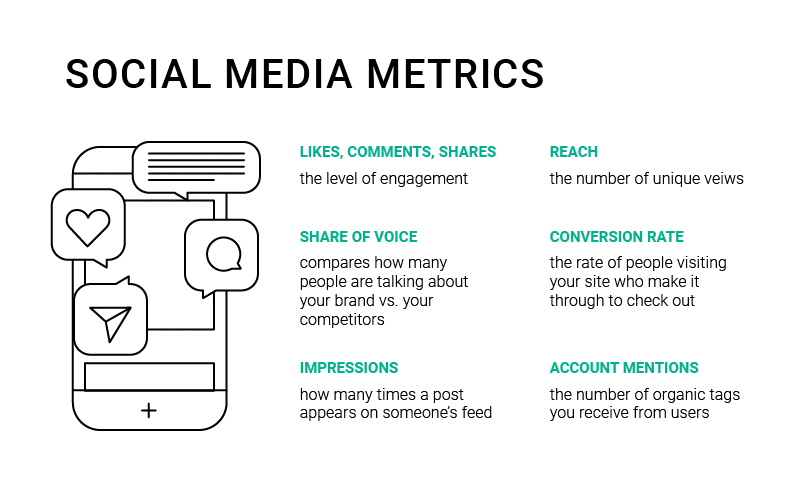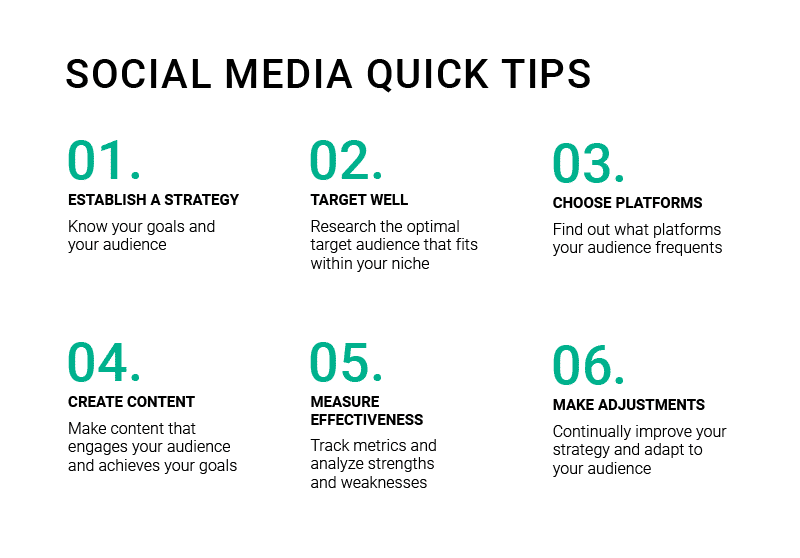Introduction
Measuring your social media reurn on investment (ROI) is essential to social media budgeting and strategy. It allows you to take your social media’s pulse and adjust your strategy accordingly. Understanding how to track your ROI will help you focus on successful content and limit your spending on unsuccessful initiatives. This post will provide tips and tricks as well as some recommended tools to help you successfully track your social media ROI.
What is the purpose of social media?
With 42% of the world’s population captivated by social media, businesses miss out on a great marketing tool if they don’t have a social media presence. Social media platforms are gateways for businesses to interact with their customers. Customers have a view of a business’s mission and values through social media. Since social media platforms are built for sharing, people can share products and services that they like. As a result, businesses expand their brand awareness. And as social media platforms are prioritizing personal posts over businesses, looping in a social media advertising campaign can help increase your social ROI.

Businesses strategically use social media not only to gain brand awareness but to generate soft leads as well. There is a give and take on social media. Companies offer giveaways in return for followers, likes, comments, shares, and emails. Through this exchange, customers have a memorable experience with the company and the business can further the relationship with the customer.
Social media can also be a form of business verification. A customer will search for a company on social media as a part of their verification process. With a strong social media presence, companies can build rapport with potential customers. If a customer sees that a company has high social media engagement, they will see that the company is worthy of their trust.
Why does social media ROI matter?
Gaining a social media presence requires a lot of investment both in time and money. Much like any other investment your company makes, you need to understand the return on investment for social media efforts. By calculating your ROI, you gain a deeper understanding of your engagement and effectiveness on social media. The purpose of social media ROI is to see the impact of your social media strategy on a larger scale than just a dollar to dollar exchange. It looks into the greater influence your social media presence is having on your audience.
Measuring the return on social media investment helps refine your social media campaigns. Social media metrics provide an understanding of the strengths and weaknesses of your social media presence. Once you identify strengths and weaknesses, applying a monetary value to those metrics will guide social-media-based decisions. For example, your social media strategy may involve pouring resources into targeting a demographic that isn’t engaging with your content. Running split testing based on past metrics will reveal the ideal strategy for your target audience and can present new social media opportunities. Not only can you refine your social media presence, but you also will gain a better picture of your audience and their interests.
Analyzing and applying value to social media metrics is key to maximizing your investment in social media advertising. Your time is valuable, particularly if the time you are taking to build your social media presence is taking away from running your business. By calculating ROI, you can focus your time on areas of opportunity rather than parts of social media that are not bringing in enough return.
Ways to measure social media ROI
Two key parts of measuring ROI include identifying your investment and calculating the worth of your investment. To calculate return on investment, you subtract the return by your investment and divide that number by the total amount invested. Social ROI is more difficult to calculate than typical advertising ROI since it is difficult to put a monetary value onto social media engagement.

When calculating total investment, take into consideration how much time and resources you have put into social media. Anything that has been spent on social media should be included in this total from the tools you’ve used to your advertising costs. Record time spent working on social media and apply an hourly cost of that time. Include any cost of outsourcing photography, content creation, or overall management. Adding all relevant costs will give you a comprehensive total investment.
Continually track metrics during the implementation of your social media strategy. Metrics like new followers, likes, comments, conversion rates, and email signups will give you insight into how well your content is achieving your goals. Calculate the lifetime value of a customer to understand the impact of converting engagement into brand loyalty. If your goal is to stimulate sales, calculate your average sale amount. The lifetime value of customers and average sales are great ways to assign a monetary value to the analytics you collect. This social ROI calculator is a great tool to break down how your investment is doing. (https://hootsuite.com/tools/social-roi-calculator)
Understanding social media metrics
It seems like there are countless ways to track social media. It can be easy to get lost in the jargon and lose sight of your goals. While it is helpful to understand the various metrics of social media, it is important to understand what specifically your business needs to track to achieve your goals.
The first step in tracking social media metrics is understanding your goals. Are you aiming to increase conversions or website traffic? Or do you want to disseminate brand awareness? Each social media goal has specific metrics that measure your effectiveness at reaching your goal.
Before deciding on what metrics to focus on, you need to understand the meaning behind them.

Next, you need to focus on the metrics that point to growth toward your goal. For increased conversion, look at the social media traffic that is bringing in customers and your website’s conversion rate. For brand awareness, analyze reach, impressions, new followers, likes, and comments. If you are wanting to expand your email list, look at the click-through-rate for the ads prompting email signup.
Measuring and analyzing metrics looks different on each platform. Facebook has in-depth analytics integrated into its section for businesses. Twitter has its version of Facebook analytics with less depth in data. Pinterest and Instagram also have analytics that are only available to business accounts. If you have a multi-channel social media strategy (as you should) finding a good tool for tracking will save you time while providing you with a full view of how your content is doing.
Social media ROI tools
The equation “(return-investment) / investment” calculates ROI which is simply done when both elements are monetarily based. However, it can be difficult to calculate your social media return and investment. The internet is here to help. There are endless amounts of tools available to calculate your social media ROI, both free and paid. Here are some of the most common tools used for tracking your social media.

Google Analytics
- Multi-platform
- Website Traffic
- General Metrics
Facebook Insights
- Single Platform
- Post Engagement
- Scheduled Posts
HootSuite
- Multi-platform
- Analytics
- Scheduled Posts
- Price: $129-$599 per month
Buffer
- Multi-platform
- Analytics
- Scheduled Posts
- Price: $15-$399 per month
Sprout Social
- Multi-platform
- Analytics
- Scheduled Posts
- Trend Analysis
- Price: $99-249 per month
Quick tips to improve social media ROI
Establishing a clear social media strategy is the first step to improving ROI. By having a plan and sticking to it, you will achieve your goals and increase your return on the time and resources you invest in social media.

A great social media strategy begins with great targeting. Understand who your target audience is. What are their interests, habits, and values? Once you know what audience fits within your company’s niche, you’ll be able to create a strategy that will optimize engagement.
After you know your audience’s social media habits, choose the platforms that reach them best. Depending on their demographics, your audience may prefer one social media platform over the other. This doesn’t necessarily mean that you should ignore the less frequented platform. It solely gives you a platform to focus your attention on.
You know who and you know where, now it’s time to create the what. Content should always be created with the audience in mind. What is going to motivate your audience to act in a way that achieves your goals? Consider tone, aesthetic, and the call to action.
Once your content is live, continually measure its progress toward your goal. Use analytics to record how users are interacting with the content. Analyze what types of posts are gaining the interest you need and what types are falling short.
Measuring metrics gives you a good idea of how your posts are doing but measuring without adjusting is useless. Take what you learn from the data and apply it to new posts. People are not static in their interest; therefore, your social media strategy should not be either.
Conclusion
Measuring social media ROI is more than just understanding where your investment is going. By knowing your ROI you can assess and tweak your social media strategy. Continually tracking and adjusting your content will help you adapt to your audience and successfully leverage your social media presence.
Sources
https://blog.hootsuite.com/measure-social-media-roi-business/
https://sproutsocial.com/insights/social-media-roi/
https://www.wordstream.com/blog/ws/2013/04/25/social-media-roi
https://buffer.com/library/guide-calculate-social-media-roi
https://sproutsocial.com/insights/social-media-metrics/
https://rmimpr.com/best-tools-measure-marketing-roi/

Recent Comments